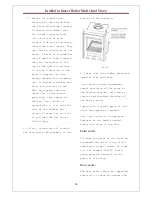
InisBofin Insert Boiler Multi-fuel Stove
8
get heat to the room as early as
possible.
Light the fire and with the door
lock engaged but the door slightly
ajar let the fire light up. After
the kindling is well alight add
larger pieces of fuel to the fire
and after a few more minutes this
fuel should be well alight. The
stove can be fully loaded now and
a bright high temperature fire
should result. Once the fire is
well alight the door can be fully
closed. When using wood fuel, at
this point the grate can be
closed. The stove damper will
normally not require adjustment
down until after at least forty
five minutes, as the stove will
take this time to fully heat up.
Under normal conditions the damper
will be moved between fully opened
and half way closed.
Refuelling
Do not let the fire burn down too
low before refuelling as the new
fuel will smoke excessively and
will require a long time to become
fully alight. Open the damper
fully every time you refuel the
stove for at least five to ten
minutes to aid rapid lighting of
the new fuel (not necessary when
using dry wood fuel). This will
help prevent excessive smoking and
will help to keep the stove and
the glass clean. Once the new fuel
is well alight, the damper can be
adjusted down to an appropriate
setting.
Continuous burning
The InisBofin insert boiler stove
is capable of continuous burning
making overnight burning possible
at a reduced output. To achieve
overnight burning, open the damper
fully and fill the firebox) with a
full charge of fuel and let it
ignite fully (Empty the ash pan if
using solid fuel). When the fire is
burning brightly, the stove damper
can then be closed down. With the
damper mostly closed and the
correct draft in the chimney, an 8-
12 hour burn time is possible. For
more heat output over a shorter
time span the damper can be opened
up as necessary. To avoid excessive
blackening of the glass the damper
should be left slightly open.
To revive the fire after overnight
burning, riddle the grate, refuel
the firebox with a small amount of
light kindling fuel and open the
damper fully. A strong fire for at
least twenty minutes is required
to burn off excess build-up of
soot deposits after a prolonged
period at low output.
Please bear in mind that operating
the stove at very low outputs is
not the most efficient way to burn
the fuel and the stove and chimney
will require more cleaning with
the possibility of creosote build-









































